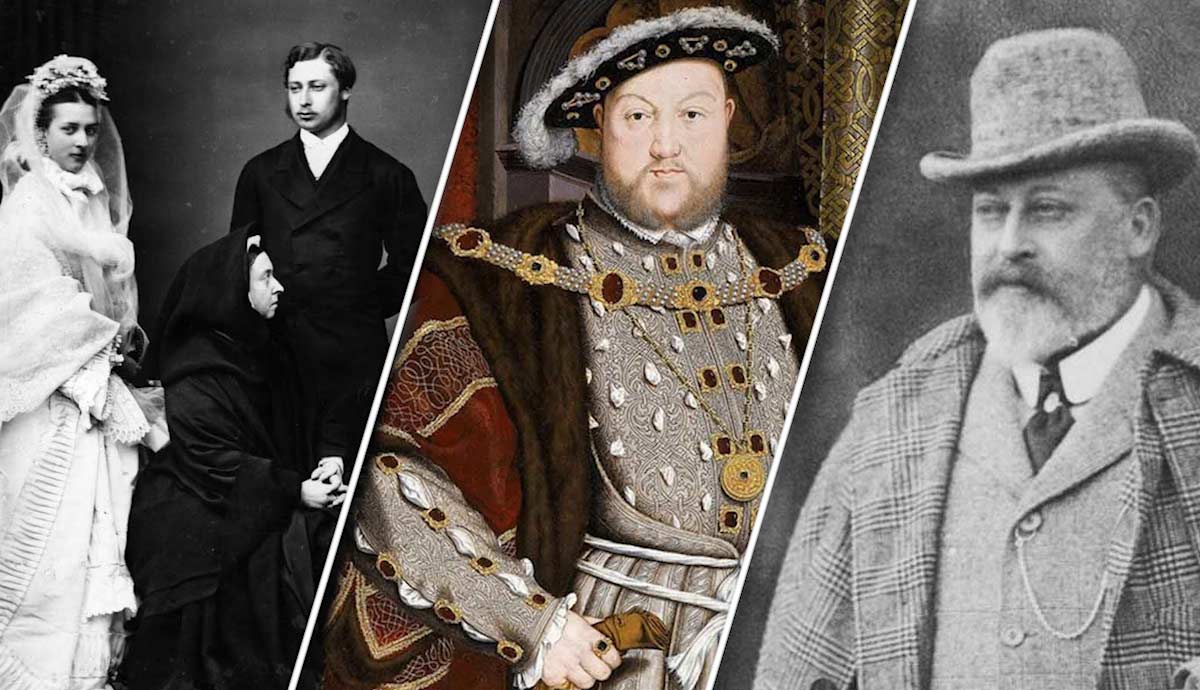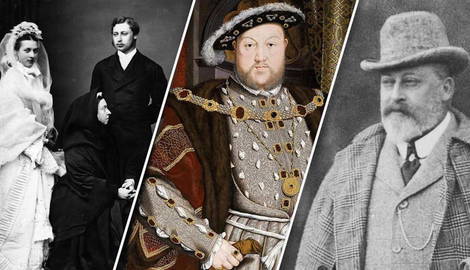
Though monarchy is an institution of the past in many parts of the world, royalty has been an essential facet of history. Royals held positions of political, economic, and social power for centuries and were expected to act accordingly. Kings and queens and the branches of their family trees were respected, and admired; people longed to be them. Unsurprisingly, they also snuck around, caused scandals, and were whispered about. These stories of royals behaving badly include greed, lust, and breaking societal norms—but after all, they were only human, right?
Henry VIII

Perhaps best known for his rapid succession of six wives, Henry VIII of Tudor England was a notorious royal bad boy. Perhaps some of his scandalous actions can be attributed to the burdens and expectations placed on him from a young age. He was the “spare” son of Henry VII and his wife, Elizabeth of York, with his older brother Arthur poised to take the throne. However, when Henry was only 11, his brother died suddenly, and Henry’s life drastically changed. He became the heir apparent, suffering under an overprotective father. Less than a year later, his mother died from complications of childbirth, devastating the boy. Nevertheless, Henry persevered and became king at age 17 after his father’s death in April 1509.

Henry’s first move as king was to marry his dead brother’s wife, Katherine of Aragon, a Spanish princess. While successful on the battlefield and in politics, Henry desired a male heir to ensure the continuation of his family line, especially after the heartbreak he’d been through with his own family. After a miscarriage, Katherine gave birth to their son, but the overjoyed couple was shattered when he died at just a few weeks old. She had a daughter a few years later but would also go on to experience at least 5 miscarriages and stillbirths.
Henry’s hopes for a son began to dwindle, and his eye began to wander. He fell in love with young Anne Boelyn, but she refused him unless he divorced. Henry was unable to obtain said divorce, as Katherine’s nephew, the Holy Roman Emperor, held great influence over the pope, the only person who could grant one. Undeterred, Henry decided to break with the Catholic Church, converting the entire country to the Church of England and declaring himself the head.

He banished Katherine, leaving her bereft and unable to see her daughter, and she died three years later. Henry and Anne married, but after three years, she had produced only a daughter. He accused her of adultery and treason and, after a sham trial, she was executed. The king was free to move on. He had already found a replacement wife in one of Anne’s ladies-in-waiting, Jane Seymour. Jane would give him a son, the future Edward VI, in 1537. However, Jane did not survive the birth. Henry went on to marry three more women: Anne of Cleves, Catherine Howard, and Katherine Parr. Howard would also be executed.

In addition to his roller-coaster love life, Henry VIII was known to have a volatile temper. He executed political rivals or even former supporters who crossed him. He upended England’s religious ties to meet his personal needs and passed discriminatory laws relating to witchcraft and homosexuality, which led to the persecution and death of many over the following centuries. While he was also intelligent, an esteemed athlete in his younger years, a musician and songwriter, and art collector, these attributes are overshadowed by his tyrannical and scandalous actions during his 36-year reign.
Edward VII

With nicknames like “Dirty Bertie” and “Edward the Caresser,” it’s a pretty safe bet that King Edward VII of England got into some romantic trouble, particularly in his younger days. The oldest son of the “grandmother of Europe,” Queen Victoria, Edward had some big shoes to fill, and he was expected to act a certain way as he prepared and trained to ascend the throne someday. Edward, however, paid no mind to said expectations and gained quite a reputation as a womanizer when he was a young man. While stationed in Ireland with the army, he began a scandalous affair with an actress, Nellie Clifton. His parents were so upset that his father, Prince Albert, visited his son to speak with him and remind him of his responsibilities to his family and country. Just a few weeks later, Albert fell ill and died, devastating Victoria. She felt that Albert’s stress over the affair and visit contributed to his death, and for the rest of her life she held Edward responsible for his father’s demise.

Queen Victoria matched her son with Queen Alexandra of Denmark in both a political move and a bid to tame his appetites. Though he and Alexandra would have five children, Edward continued to have many affairs throughout his marriage. The list of women he had trysts with is long and includes actresses, wives of nobles, prostitutes, performers, and singers. Contributing to his playboy reputation was his fondness for alcohol and gambling.

Despite his casanova lifestyle, Edward VII went on to be an effective ruler upon his mother’s death in 1901, favored by a majority of the British citizenry. He became well known for his diplomatic skills and used his affability to his advantage in these matters.
King Mswati III of Eswatini

The only ruler on the list who is currently still in power, Mswati is notorious for a number of reasons. The leader of Eswatini (formerly Swaziland) in southern Africa, Mswati ascended to the throne at only 18 years of age in 1986, becoming the world’s youngest monarch. Currently, he is Africa’s only absolute monarch, with the power to appoint people to government posts and pass laws of his choosing. He has 15 wives and 36 children, some of his brides just teens at the time of their marriages.

Eswatini has the world’s highest HIV infection rate per capita, which contributes to one of the lowest life expectancies in the world, 57 years. Despite repeated warnings from public health officials beginning in 1993, Mswati made no efforts to address the HIV situation until 1999. At that point, he declared HIV a national disaster, but no formal action was taken. In 2001, however, he instituted a law that banned all women under the age of 18 from having sex, wearing trousers, or even shaking hands with men. As expected, this decree did nothing to solve the HIV crisis over the five years it was in effect. In the meantime, the king took a 17-year-old wife, fining himself for his misdeed. While antiretrovirals, the drugs that are used to slow HIV infection and the onset of full-blown AIDS, have become widely available, many people in Eswatini are unable to take advantage of them. Due to hunger and malnutrition, their bodies are not strong enough to tolerate the drugs.

While 59% of the Eswatini population lives in poverty (about 29% are considered to be in extreme poverty), Mswati lives a comfortable life, with 19 Rolls Royces and 120 BMWs to his name. He banned photography of his cars after receiving public criticism. His personal wealth was estimated at over $200 million in 2008. Meanwhile, the majority of his countrymen are living on less than $4 a day.
Rudolf of Austria

Nineteenth-century crown prince of Austria-Hungary, Rudolf, was another notorious womanizer. A cousin said he was “mad about women” from a young age, though he didn’t necessarily appreciate them as human beings—he was interested in sex. He is alleged to have had over 30 illegitimate children, their mothers silenced with bribes or threats. Rudolf would never wear the crown, however. In January 1889, a worried servant broke down the door of a locked bedroom and found the bodies of Rudolf and his seventeen-year-old mistress, both dead from gunshot wounds. The mistress, Baroness Mary Vetsera, appeared to have been dead several hours longer than Rudolf, suggesting he may have killed her…or was it a suicide pact? To this day, no one knows the answer.
Juan Carlos of Spain

Ascending to the Spanish throne in 1975, Juan Carlos was seen as a bright light for the future of his country. After the brutal rule of the fascist Francisco Franco, Spain was ready for positive change, and Juan Carlos seemed poised to offer that. However, by the time the 21st century rolled around, Juan Carlos found himself unpopular with his people. He had gained a reputation as a playboy and was criticized for living a lavish lifestyle while citizens suffered through an economic collapse. He decided to abdicate, leaving the throne to his son Felipe.

The whole situation was made even messier by his daughter, Infanta Cristina, and her husband, who were charged with a number of financial crimes, including embezzlement, fraud, and tax evasion. Princess Cristina was stripped of her royal titles and left the country, while her husband went to prison. Even after he stepped down, Juan Carlos experienced public scrutiny as prosecutors investigated him in three separate cases relating to financial crimes and corruption. He was also sued by a former lover who accused him of spying on her. He decided to go into self-exile and left the country in 2020.










